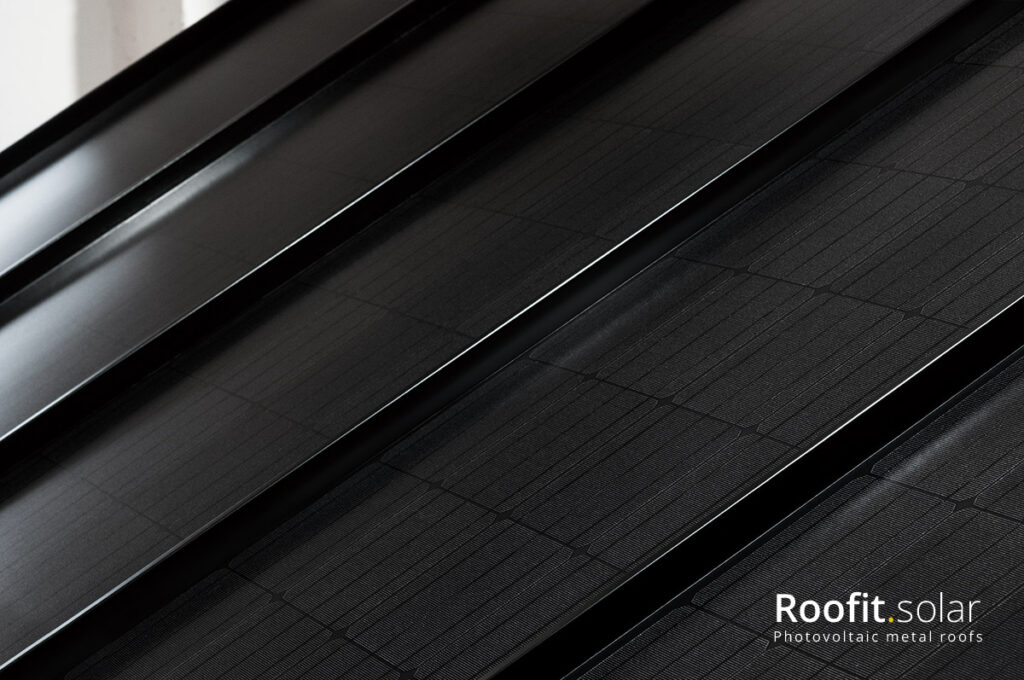Newer research has proven that solar panels are more suitable than you might think also on latitudes in the far north. Estonian company Roofit Solar Energy has created their concept on the theme – a metal roof with integrated photovoltaic solar cells – suited for the weather conditions in Scandinavia and the Baltic Region.
“According to the latest technology the solar cells are laminated on the metal roofing material. You can use the solar material on the entire roof or – depending on your preferences and energy output wishes – to some parts of the roof. It looks like a normal metal roof, but it is a roof that really contributes to a green energy solution for the building,” says Helen Anijalg, Marketing and export manager at Roofit.solar.
Set aside the aesthetical values, the main advantage compared to conventional solar panels is the installation cost and environmentally thinking – less layers of different materials on roof. Instead of mounting the roof and the solar panels separately you install them both simultaneously.
“It is almost as easy to install as an ordinary roof. This really saves time and labor cost. We also supply full information about the installation to make it as smooth as possible.”
Sustainable energy for every household
The roof panels come in two sizes, 515 x 1640 mm weighing 11.6 kg and 515 x 1995 mm weighing 14 kg. The smaller produces 105 W and the larger 130 W. The metal sheet thickness is 0,5 mm, but the final product is 4mm thick. The standard color is colors is black as most cost-efficient material. but. For a full roof the production will depend on roof size and the location/roof angle, for example 100 m2 roof will be ca 14kW.
The panels are suitable for new buildings like private homes or public buildings or for complete roof renovations. Each solar panel can produce 105-130 W depending on size. Excess energy can be fed to the grid or be used to charge an electrical car. But what about the life-time?
Solar panels will last for at least 30 years
“All solar panels experience a small degrade annually. The roof materials as such have a lifetime of 50+ years. Our solar part of the roof can last for more than 30 years. After 30 years you can still have 85 % of initial power output.”
The material has also been tested for impact of heavy hail, mechanical impact and overall strength with no damage to either the surface or the energy production function. But what about dust of other debris, will that affect the function?
“This has not been a problem; the rain does the cleaning. And fortunately, there is a lot of rain on our latitudes in the north of Europe.”
Energy to the grid
All solar panels produce excess energy during the summer months and the surplus is possible to feed and sell to the general grid.
“This is of course an option that is interesting, but also dependent on the current feeding tariffs and ultimately a political question on how you want to promote solar energy and those who invest in solar panels. As an alternative use of the energy not needed in the household can be used for charging an electrical car.”
About the company
Roofit.solar is a relatively new company and the first roofs were installed in 2017 and have operated since then. The team behind Roofit.solar has experience in research, large-scale international energy projects, production and material science as well as export. Roofit.solar initially aims for the markets in Scandinavia and later rest of Europe. More information: https://roofit.solar/ (in English)
Background: This article is made in the framework of the project Effective Financing Tools for implementing Energy Efficiency in Buildings (EFFECT4buildings). The aim of the article is to share of experiences on energy efficiency solutions. EFFECT4buildings project develop a toolbox with a set of financial instruments for building managers to implement more energy efficiency measures. The project also maps, promote and share experiences among building managers of different technology solutions for energy efficiency in buildings. EFFECT4buildings is implemented with the support from the Interreg Baltic Sea Region Program 2014-2020 (European Regional Development Fund) and Norwegian national funding. For more information: http://www.effect4buildings.se
Follow us on Twitter @EFFECT4building
Disclaimer: The sole responsibility for the content of this article lies with the authors. It does not represent the views of the European Union.













